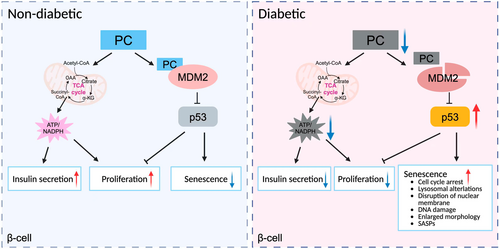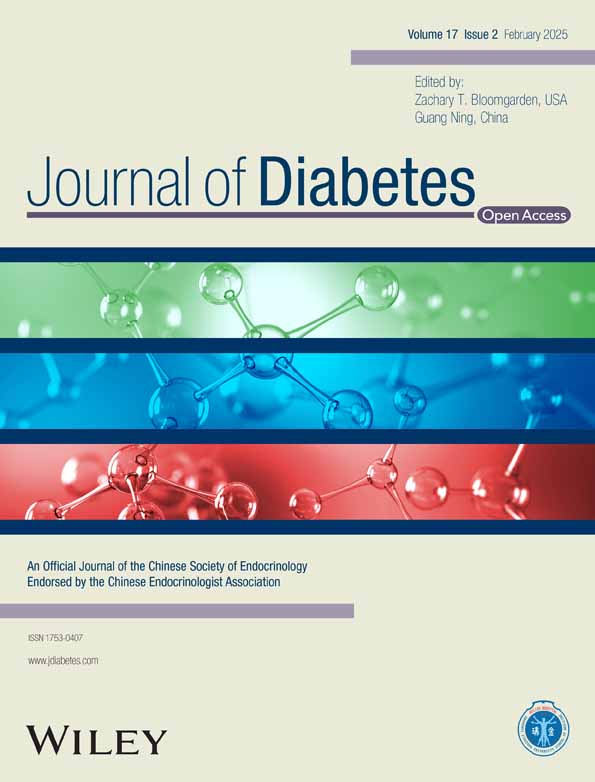Pyruvate Carboxylase as a Moonlighting Metabolic Enzyme Protects β-Cell From Senescence
Yumei Yang
Department of Endocrinology and Metabolism, Zhongshan Hospital, Fudan University, Shanghai, China
Search for more papers by this authorBaomin Wang
Department of Endocrinology and Metabolism, Zhongshan Hospital, Fudan University, Shanghai, China
Search for more papers by this authorCorresponding Author
Xiaomu Li
Department of Endocrinology and Metabolism, Zhongshan Hospital, Fudan University, Shanghai, China
Correspondence:
Xiaomu Li ([email protected])
Search for more papers by this authorYumei Yang
Department of Endocrinology and Metabolism, Zhongshan Hospital, Fudan University, Shanghai, China
Search for more papers by this authorBaomin Wang
Department of Endocrinology and Metabolism, Zhongshan Hospital, Fudan University, Shanghai, China
Search for more papers by this authorCorresponding Author
Xiaomu Li
Department of Endocrinology and Metabolism, Zhongshan Hospital, Fudan University, Shanghai, China
Correspondence:
Xiaomu Li ([email protected])
Search for more papers by this authorFunding: The authors received no specific funding for this work.
Conflicts of Interest
The authors declare no conflicts of interest.
References
- 1S. Farfari, V. Schulz, B. Corkey, and M. Prentki, “Glucose-Regulated Anaplerosis and Cataplerosis in Pancreatic Beta-Cells: Possible Implication of a Pyruvate/Citrate Shuttle in Insulin Secretion,” Diabetes 49 (2000): 718–726.
- 2Y. Q. Liu, J. Han, P. N. Epstein, and Y. S. Long, “Enhanced Rat Beta-Cell Proliferation in 60% Pancreatectomized Islets by Increased Glucose Metabolic Flux Through Pyruvate Carboxylase Pathway,” American Journal of Physiology. Endocrinology and Metabolism 288 (2005): E471–E478.
- 3A. Fu, L. van Rooyen, L. Evans, et al., “Glucose Metabolism and Pyruvate Carboxylase Enhance Glutathione Synthesis and Restrict Oxidative Stress in Pancreatic Islets,” Cell Reports 37 (2021): 110037.
- 4A. Fu, J. C. Alvarez-Perez, D. Avizonis, et al., “Glucose-Dependent Partitioning of Arginine to the Urea Cycle Protects β-Cells From Inflammation,” Nature Metabolism 2 (2020): 432–446.
- 5M. J. MacDonald, M. J. Longacre, E. C. Langberg, et al., “Decreased Levels of Metabolic Enzymes in Pancreatic Islets of Patients With Type 2 Diabetes,” Diabetologia 52 (2009): 1087–1091.
- 6J. Han and Y. Q. Liu, “Reduction of Islet Pyruvate Carboxylase Activity Might Be Related to the Development of Type 2 Diabetes Mellitus in Agouti-K Mice,” Journal of Endocrinology 204 (2010): 143–152.
- 7Y. Yang, B. Wang, H. Dong, et al., “The Mitochondrial Enzyme Pyruvate Carboxylase Restricts Pancreatic β-Cell Senescence by Blocking p53 Activation,” Proceedings of the National Academy of Sciences of the United States of America 121 (2024): e2401218121.
- 8A. Helman, A. Klochendler, N. Azazmeh, et al., “p16(Ink4a)-Induced Senescence of Pancreatic Beta Cells Enhances Insulin Secretion,” Nature Medicine 22 (2016): 412–420.
- 9M. Patra, A. Klochendler, R. Condiotti, et al., “Senescence of Human Pancreatic Beta Cells Enhances Functional Maturation Through Chromatin Reorganization and Promotes Interferon Responsiveness,” Nucleic Acids Research 52 (2024): 6298–6316.
- 10P. Carapeto, K. Iwasaki, F. Hela, et al., “Exercise Activates AMPK in Mouse and Human Pancreatic Islets to Decrease Senescence,” Nature Metabolism 6 (2024): 1976–1990.
- 11C. Aguayo-Mazzucato, “Functional Changes in Beta Cells During Ageing and Senescence,” Diabetologia 63 (2020): 2022–2029.
- 12F. Kruiswijk, C. F. Labuschagne, and K. H. Vousden, “p53 in Survival, Death and Metabolic Health: A Lifeguard With a Licence to Kill,” Nature Reviews. Molecular Cell Biology 16 (2015): 393–405.
- 13S. Tornovsky-Babeay, D. Dadon, O. Ziv, et al., “Type 2 Diabetes and Congenital Hyperinsulinism Cause DNA Double-Strand Breaks and p53 Activity in β Cells,” Cell Metabolism 19 (2014): 109–121.
- 14M. F. Rubin de Celis, R. Garcia-Martin, I. Syed, et al., “PAHSAs Reduce Cellular Senescence and Protect Pancreatic Beta Cells From Metabolic Stress Through Regulation of Mdm2/p53,” Proceedings of the National Academy of Sciences of the United States of America 119 (2022): e2206923119.
- 15M. H. Kubbutat, S. N. Jones, and K. H. Vousden, “Regulation of p53 Stability by Mdm2,” Nature 387 (1997): 299–303.
- 16J. Cha, C. Aguayo-Mazzucato, and P. J. Thompson, “Pancreatic β-Cell Senescence in Diabetes: Mechanisms, Markers and Therapies,” Frontiers in Endocrinology 14 (2023): 1212716.
- 17M. N. Gupta and V. N. Uversky, “Moonlighting Enzymes: When Cellular Context Defines Specificity,” Cellular and Molecular Life Sciences 80 (2023): 130.





